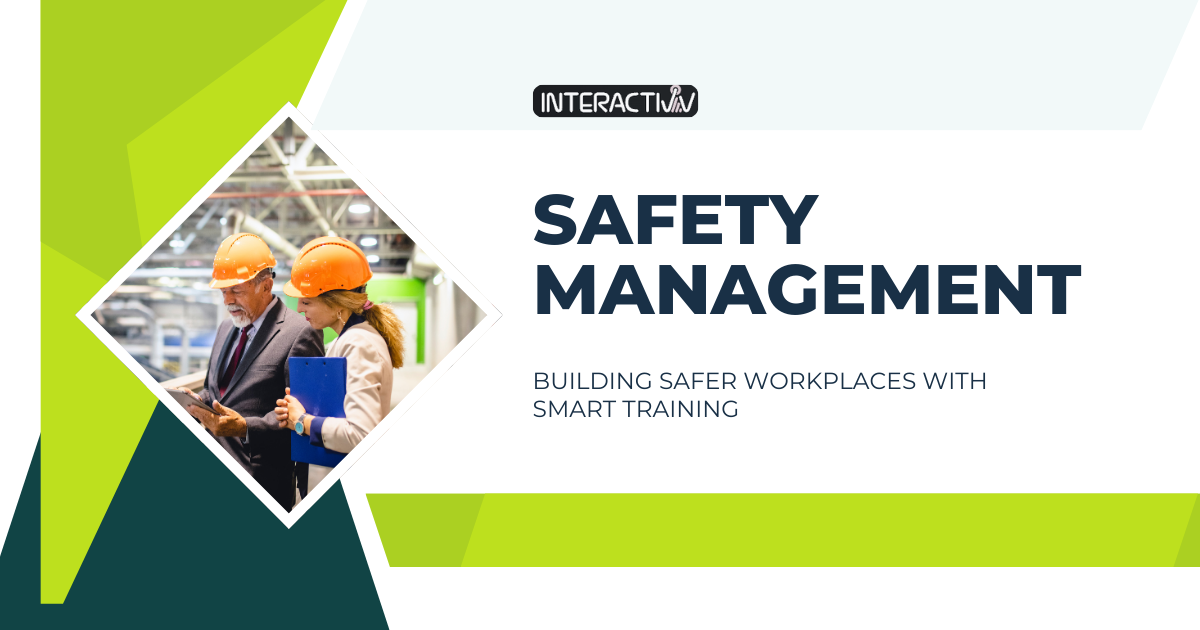Sep 10th, 2025

In every industry, from construction and manufacturing to healthcare and corporate offices, safety has become a top priority. A single accident can cost a company financially, legally, and reputationally. More importantly, it can impact lives forever. This is why safety management plays a vital role in today’s workplaces.
For modern businesses, safety management is not just about fulfilling compliance requirements; it’s about building a culture where employees feel safe, supported, and confident in their work environment. In this blog, we’ll explore the fundamentals of safety management, its importance, key elements, and how organizations can leverage modern tools like interactive videos and digital training to achieve better results.
Safety management refers to the organized process of identifying, assessing, controlling, and continuously improving workplace safety measures. It involves a combination of policies, training, monitoring, and proactive actions designed to reduce risks and prevent accidents.
A safety management system (SMS) is typically made up of these core functions:
Companies that commit to structured safety management demonstrate that employee well-being is at the heart of their operations.
Today’s workplaces face increasing risks—advanced machinery, evolving technologies, high-pressure deadlines, and diverse teams working under challenging conditions. An effective safety management strategy ensures:
Businesses that fail to invest in safety management often face higher turnover, frequent disruptions, and long-term reputational damage.
An effective safety management system goes beyond documents and checklists. It includes:
Regular inspections help uncover potential hazards, from faulty equipment to unsafe work practices. Once identified, risks are ranked by severity and addressed before they cause harm.
Employees must be equipped with the right knowledge to handle workplace risks. Modern training programs use engaging methods—like simulations, e-learning, and safety video animation—to ensure workers retain knowledge and can act quickly in emergencies.

workplace safety PPE
A company should maintain written policies, procedures, and records. This ensures clarity, accountability, and proof of compliance during audits.
Workplaces must have clear evacuation plans, fire drills, first-aid readiness, and crisis communication strategies.
From AI-driven monitoring systems to interactive dashboards, technology is revolutionizing safety management. Businesses can now track safety data in real-time and respond faster to potential issues.
Safety is never static. Organizations must regularly update their systems, embrace innovation, and learn from near-misses to create a culture of continuous improvement.
Training is one of the most powerful tools for creating safer workplaces. Without employee awareness, even the best safety policies remain ineffective.
Traditional training sessions often rely on manuals and classroom lectures, which may not always engage today’s workforce. Instead, companies are adopting interactive training methods that include video-based learning, gamified modules, and scenario-based simulations.
Interactive training is not only more engaging but also ensures employees remember what they learn. For instance, animated safety videos can visually demonstrate accident scenarios, showing employees how to react in real time. This kind of learning is far more impactful than reading a handbook.
If you’re a business owner or HR manager looking for safety training near me , the key is to choose a provider that blends compliance with creativity—ensuring your workforce stays both informed and motivated.
At Interactivv.com, we specialize in designing custom solutions for safety management that transform the way companies train their employees. Our approach focuses on making complex safety protocols easy to understand through visual learning and interactive experiences.
Here’s how we help:
By combining creativity with compliance, we ensure that employees don’t just learn safety—they live it.
Safety management is not only about systems and training but also about culture. Employees must feel encouraged to report hazards, share feedback, and take responsibility for their actions. When leadership demonstrates commitment to safety, employees naturally follow suit.
Building a safety-first culture includes:
When safety becomes part of everyday thinking, workplaces become not just safer but more productive.
Safety management is a long-term investment in people, performance, and profitability. Companies that prioritize safety protect lives, reduce risks, and position themselves for success. With tools like interactive videos, animations, and digital training modules, businesses can create a safety culture that lasts.
At Interactivv.com, we are committed to helping organizations build smarter, safer workplaces through innovative training solutions. Whether you’re in construction, manufacturing, healthcare, or corporate sectors, our safety solutions are designed to meet your unique needs.
When it comes to safety, prevention is always better than cure—and the right safety management strategy can make all the difference.
In every industry, from construction and manufacturing to healthcare and corporate offices, safety has become a top priority. A single accident can cost a company financially, legally, and reputationally. More importantly, it can impact lives forever. This is why safety management plays a vital role in today’s workplaces. For modern businesses, safety management is not […]
Fill out the form below and we will send you a quote today…
Copyright © 2025 Interactivv.com. All rights reserved.